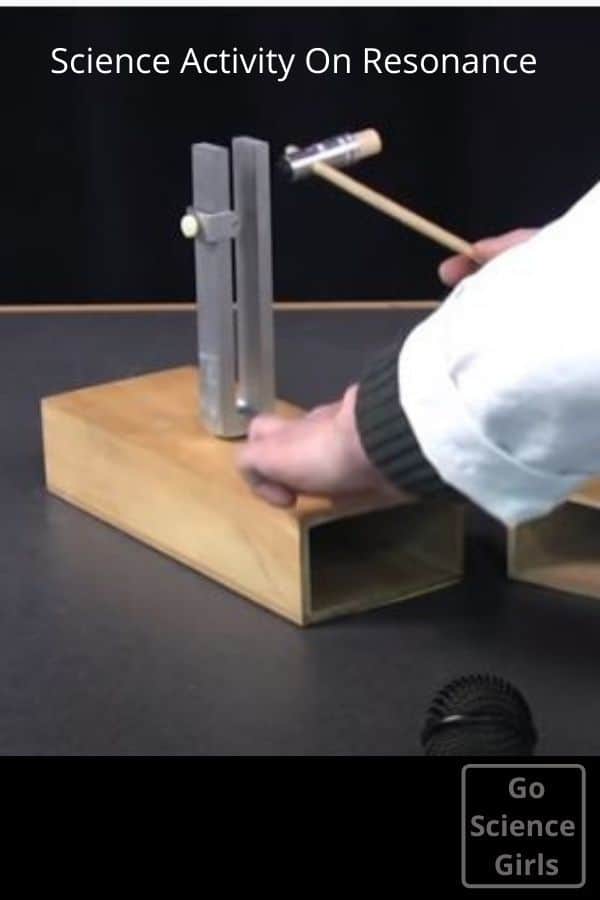This science activity video on resonance by tuning forks is an experiment that gives a deep insight into resonance, sound frequency, and pitch.
Do you know an opera singer can break wine glasses?
Yes, Jaime Vendera, the renowned voice coach, manages to shatter a wine glass with his wail in 2005 on Discovery Channel!
Interestingly, his voice that shattered the glass was registered at 105 decibels, which is far more than the conversational human speech (50 decibels).
See, already you may know that different materials on earth vibrate at varied frequencies. Frequency is nothing but the speed of vibration.
Frequency can be measured in Hertz.

All objects can vibrate to produce sound. So, when you hit or strike a musical instrument, it starts vibrating at its natural frequency.
However, when that musical instrument on being struck, drives another system to vibrate at a frequency equal to its natural frequency, it is known as resonance.
Let’s experiment to develop a better understanding of resonance.
Courtesy: TSG Physics & Massachusetts Institute of Technology (MIT)
Raw materials
- Two identical tuning forks
- Two hollow boxes of the same size
- One soft striking hammer
- One tuning weight
- One microphone
Steps to follow
- Take the two identical tuning forks and place each of them on a hollow box next to each other.
- Now, place the sounding boxes, weight, and hammer on a flat surface as shown in the video.
- Position the microphone such that it can catch the sound produced by the tuning forks
- Next, drag the first tuning fork near the microphone and strike it softly with the hammer
- Now keep one of your fingers on the first tuning fork, and then your other hand on the other tuning fork
- Next, again set both the tuning forks along with their sounding boxes facing each other with a small gap in-between.
- Strike the first tuning fork with the hammer and drag the second tuning fork near the microphone.
- Next, position the second tuning fork as it was before that is facing the first tuning fork
- Now, attach the small weight to the second tuning fork with the help of a screw and strike the fist tuning fork with the hammer
- Drag the first tuning fork which is producing sound near the microphone and then place your finger on the top to stop its sound
- Next, drag the second tuning fork near the microphone to know whether it is resonating the sound of the first tuning fork or not
- Now, place both of the tuning forks facing the microphone and gently strike each of them with the hammer one by one
- You will be surprised to know that both of them are now producing different pitches of sounds

Observation
When you conduct the experiment, strike the first tuning fork with the hammer, and it begins to vibrate which will emit a single pitch sound.
Again, when keeping the finger on the top of the tuning fork, it stops vibrating. The sound also gets stopped immediately.
Next, when you strike the first tuning fork with the hammer after placing it next to the second tuning fork, observe that the second tuning fork too starts vibrating and resonating at the same pitch, which is confirmed when dragging each of the tuning forks near the microphone.
However, when again placing both of them next to each other, adding weight to the second tuning fork, and then striking the first tuning fork, the second tuning fork does not resonate with any sound, which is evident when you bring it near the microphone.
So, it is clear that the weight is behind this change because when bringing both of the forks near the microphone and striking each one of them with the hammer, the sound produced by the second tuning fork was at a different pitch.
Also, notice that the varied sound pitches are interfering with each other to create what we know as beats. See, when we hear two sound waves that are of different frequencies, we hear the sound as alternatively soft and loud. This is called producing beats.
Here, you have also come across the term pitch. So, let us understand the concept.

What is the pitch?
The pitch of a sound is the characteristic of a sound that helps our ears to differentiate a shrill sound from a flat sound. It changes as the frequency of the sound changes.
For example, both Justin Timberlake and Michael Jackson are known for their ability to sing songs in a high-pitched voice.
This simple video on resonance gives a deep insight into the world of resonance, frequency, pitch, and beats. You can easily have an idea about the power of resonance from the fact that it leads to the collapse of the famed Tacoma Bridge in Washington on November 7, 1940.
So, conduct the above science experiment on resonance and add different eight attachments to see how it is causing a difference in the produced sound pitch.
Resource
https://www.youtube.com/watch?v=aCocQa2Bcuc&feature=emb_logo
http://spluch.blogspot.com/2007/08/can-opera-singers-voice-shatter-glass.html
https://byjus.com/physics/loudness-of-sound/
https://www.howitworksdaily.com/how-can-resonance-collapse-bridges/
